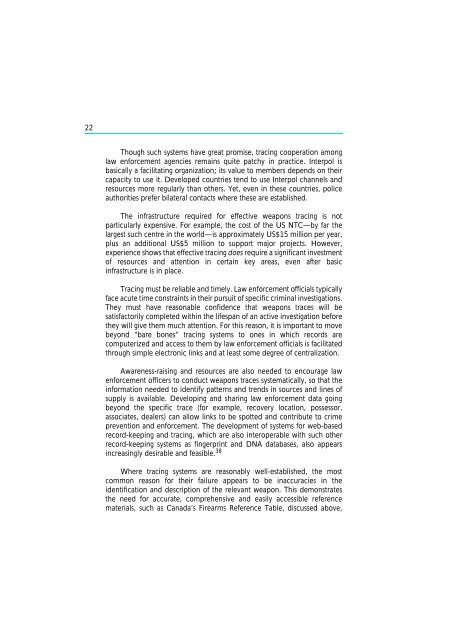The Scope and Implications of a Tracing Mechanism for Small Arms ...
The Scope and Implications of a Tracing Mechanism for Small Arms ...
The Scope and Implications of a Tracing Mechanism for Small Arms ...
Create successful ePaper yourself
Turn your PDF publications into a flip-book with our unique Google optimized e-Paper software.
22<br />
Though such systems have great promise, tracing cooperation among<br />
law en<strong>for</strong>cement agencies remains quite patchy in practice. Interpol is<br />
basically a facilitating organization; its value to members depends on their<br />
capacity to use it. Developed countries tend to use Interpol channels <strong>and</strong><br />
resources more regularly than others. Yet, even in these countries, police<br />
authorities prefer bilateral contacts where these are established.<br />
<strong>The</strong> infrastructure required <strong>for</strong> effective weapons tracing is not<br />
particularly expensive. For example, the cost <strong>of</strong> the US NTC—by far the<br />
largest such centre in the world—is approximately US$15 million per year,<br />
plus an additional US$5 million to support major projects. However,<br />
experience shows that effective tracing does require a significant investment<br />
<strong>of</strong> resources <strong>and</strong> attention in certain key areas, even after basic<br />
infrastructure is in place.<br />
<strong>Tracing</strong> must be reliable <strong>and</strong> timely. Law en<strong>for</strong>cement <strong>of</strong>ficials typically<br />
face acute time constraints in their pursuit <strong>of</strong> specific criminal investigations.<br />
<strong>The</strong>y must have reasonable confidence that weapons traces will be<br />
satisfactorily completed within the lifespan <strong>of</strong> an active investigation be<strong>for</strong>e<br />
they will give them much attention. For this reason, it is important to move<br />
beyond “bare bones” tracing systems to ones in which records are<br />
computerized <strong>and</strong> access to them by law en<strong>for</strong>cement <strong>of</strong>ficials is facilitated<br />
through simple electronic links <strong>and</strong> at least some degree <strong>of</strong> centralization.<br />
Awareness-raising <strong>and</strong> resources are also needed to encourage law<br />
en<strong>for</strong>cement <strong>of</strong>ficers to conduct weapons traces systematically, so that the<br />
in<strong>for</strong>mation needed to identify patterns <strong>and</strong> trends in sources <strong>and</strong> lines <strong>of</strong><br />
supply is available. Developing <strong>and</strong> sharing law en<strong>for</strong>cement data going<br />
beyond the specific trace (<strong>for</strong> example, recovery location, possessor,<br />
associates, dealers) can allow links to be spotted <strong>and</strong> contribute to crime<br />
prevention <strong>and</strong> en<strong>for</strong>cement. <strong>The</strong> development <strong>of</strong> systems <strong>for</strong> web-based<br />
record-keeping <strong>and</strong> tracing, which are also interoperable with such other<br />
record-keeping systems as fingerprint <strong>and</strong> DNA databases, also appears<br />
increasingly desirable <strong>and</strong> feasible. 38<br />
Where tracing systems are reasonably well-established, the most<br />
common reason <strong>for</strong> their failure appears to be inaccuracies in the<br />
identification <strong>and</strong> description <strong>of</strong> the relevant weapon. This demonstrates<br />
the need <strong>for</strong> accurate, comprehensive <strong>and</strong> easily accessible reference<br />
materials, such as Canada’s Firearms Reference Table, discussed above,
















